#paleomagnetism
Text
#MagneticMysteries#EarthScience#GeomagneticField#ScienceExploration#SouthernHemisphereResearch#InnovationInScience#Paleomagnetism
0 notes
Note
hey I really like your game concept. I absolutely love steampunk settings, and also love the witcher and FMA. greatly looking forward to stuff, so naturally I have to ask what the ROs opinons are on the effect of paleomagnetism on continental drift?
?
7 notes
·
View notes
Text
The Earth's magnetic field is getting weaker: Behold the atypical anomalies confirming the approaching of dark days for humanity

Every 12,000 years, global catastrophes occur on Earth. The conclusion about the presence of such a cycle was made on the basis of a large-scale interdisciplinary study of traces of catastrophes based on ice cores, bottom sediments, traces of floods, ash layers of eruptions, megafires, paleomagnetic events, tectonic reconstructions, archaeological materials, and much more. It is important to understand that these cyclic catastrophes on geological time scales occur almost instantly.
In the last cycle of catastrophes between the sharp warming and the subsequent cooling of the Younger Dryas, in just a few decades, a planetary catastrophe occurred, leading the planet to the Great Flood. Due to the suddenness of these climatic events, non-specialists and journalists interpreted it as the result of a meteorite impact, that is, it happened so abruptly and unexpectedly, however, those who comprehensively studied the events of the Later Dryas are sure that a sharp warming and subsequent cooling occurred precisely because of volcanic eruptions. In addition, at the same time, a drift of the poles was taking place on the planet, which could in no way be connected with the fall of the meteorite.
Catastrophic volcanic eruptions and sudden changes in the magnetic field have something in common, and one reason - this is the destabilization of the core of our planet by external cosmic influence, which affects the planets of the entire solar system once every 12 thousand years.
In every 12,000-year cycle of catastrophes, the Earth's magnetic poles drift, which we still observe today. The pole shift 12 thousand years ago is called Gothenburg excursion, 24 thousand years ago - Lake Mungo, 36 thousand years ago - Mono Lake, 48 thousand years ago - Laschamp and so on.
Also in past cycles, there was a weakening of the magnetic field. For example, according to paleomagnetic studies during the Laschamp event, the planet's magnetosphere shrank by about 3.8 times the Earth's radius. One hypothesis claims that the extinction of the Neanderthals was due to an increased flux of ultraviolet radiation, as a weakened magnetic field began to pass it more. According to the models of scientists at the same time, auroras were observed on Earth even in the equatorial zone.
Today, the change in the Earth's magnetic field is already gaining momentum. It may seem to us that this is not such an important parameter, since we do not directly feel these changes, but in fact this is a catastrophic phenomenon that threatens all life on the planet. Let's look at what anomalies on the planet lead to changes in the Earth's magnetic field in the current cycle of 12 thousand years .
In 1995, as a result of changes in the core of our planet, the North Magnetic Pole, previously moving at a speed of 15 kilometers per year, sharply accelerated by 3.5 times. This is the result of heating the outer core and accelerating the flow of molten iron inside it.
Today, due to the weakening of the magnetic field, the South Atlantic Magnetic Anomaly is growing. Scientists tell us that over the past century, the intensity of the Earth's magnetic field has decreased by more than 10%, which means that we are threatened by a more powerful stream of cosmic radiation, such as ultraviolet radiation, and this also means that the stream of external cosmic influence is even greater. volume passes to the nucleus.
There is another possibly unexpected indicator of changes in the Earth's magnetic field, indicating a destabilization of the core - these are atypical auroras.
This year there were especially many anomalously bright and frequent auroras, including in atypical points of the planet. People posted a lot of photos and videos on social networks, admiring this phenomenon, but unfortunately there is nothing to admire here.
What is aurora?
Aurora is the interaction of solar wind particles with the Earth's magnetic field and atmosphere. In simple terms, when particles of the solar wind interact with particles of oxygen and nitrogen, this causes them to glow, which we observe as aurora. Depending on how deep charged particles can penetrate into the atmosphere and what their energy is, there will be a glow of different colors.
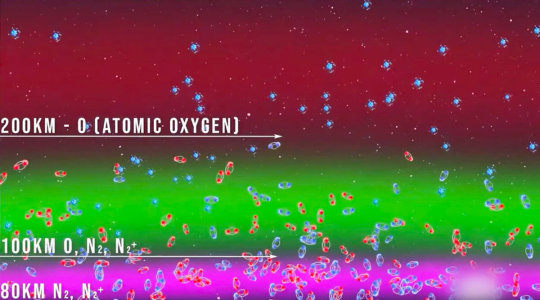
Each height has its own color, which is determined by the composition and density of the atmosphere. On Earth, we are used to seeing green aurorae, and mostly at the poles.
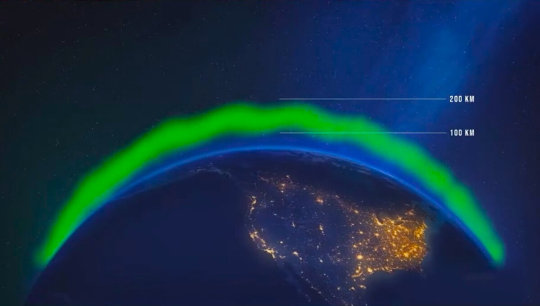
Green aurora occurs at altitudes from 100 to 200 kilometers above the earth when charged particles of the solar wind of medium energies interact with atomic oxygen. However, the glow can also be red, and it arises due to the interaction of high-energy solar wind particles with atomic oxygen. Such a poisonous red glow usually occurred at an altitude of over 200 km, since such high-energy particles were not transmitted below by the Earth's magnetic field.
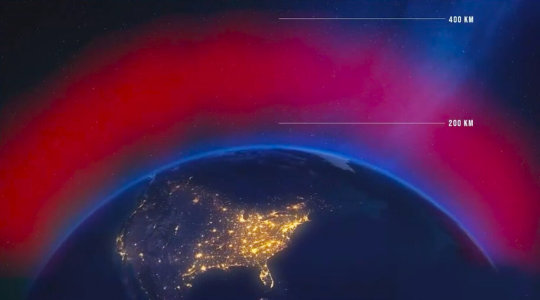
Red auroras have occurred rarely and only during intense magnetic storms, so now we are seeing a very alarming anomaly. Not only did the auroras begin to occur very often, their manifestations are already observed at an altitude already below 90 kilometers, which means that, firstly, the Earth's magnetic field is weakening and those active high-energy particles of the solar wind that should have been reflected by the magnetic shield are freely penetrate deep into the atmosphere and begin to interact with atomic oxygen closer to the Earth.
It is important to note this penetration of larger and more strongly charged particles, which act more destructively on all life on the planet, and the fact that today red auroras occur already in the lower layers of the atmosphere means that there is no longer any protection above.
The second reason auroras behave anomalously is the lowering of the upper and middle layers of the atmosphere. Our atmosphere settles, that is, sinks, and the density of its upper and middle layers decreases. Moreover, its chemical composition changes.
Now, according to satellite data, a decrease in oxygen concentration by 2-4 times at an altitude of 130 km has been revealed, and the loss rate significantly exceeds all calculated models, and this indicates a certain pathological process leading to a decrease in oxygen in the atmosphere. Scientists are also recording ozone depletion from the solar wind at 75 km, and we will soon see the ozone layer being destroyed already in the stratosphere below 50 km, which means that we will lose our protection from ultraviolet radiation.
We already see examples of red auroras in mid-latitudes, especially in February and March 2023. And on January 5, 2023, the sky over Germany was painted red.
It was an example of an anomalous static red aurora, but in addition to such red auroras, auroras of blue, turquoise, white and even pink hues have also begun to be observed, which also indicate the penetration of the solar wind closer to the Earth's surface and cracks in the magnetic field.
https://twitter.com/bbroastro/status/1650285754562519044
During solar flares, the auroras move closer and closer to the equator. So, for example, during a strong magnetic storm on March 24, 2023, which scientists could not predict in advance and did not expect its arrival, the northern lights were observed in the United States and even in southern states such as Virginia, North Carolina, Oklahoma and Arizona.
Auroras began to reach the southern latitudes of Europe, for example, to the Czech Republic, Ukraine and southern Russia.
The occurrence of atypical, bright and frequent auroras, which are now observed far from the polar regions, cannot be explained by the activity of the Sun, since the Sun is now in a protracted minimum of its activity, and a smaller number of solar wind particles come to Earth. The only explanation for the aurora anomaly is that the Earth's magnetic field is critically weakening, the atmosphere is settling and the solar wind is sinking lower and lower to the Earth's surface. This is actually scary, because such large disturbances in the magnetic field are a sign that the core of the Earth is no longer working as it should.
Few people know that there is another anomaly that indicates a local manifestation of the atypical behavior of the Earth's magnetic field. The so-called light pillars are a phenomenon that has become more frequent in the last few years.
Previously, similar phenomena were observed only during the aurora, but now they began to occur without it.
Now light pillars are observed mainly in the cold regions of the Earth at night, when there is light from lanterns. You can read that such phenomena occur due to the fact that hexagonal or columnar ice crystals hang one above the other in the air, and they illuminate the atmosphere, but remember winter night photographs 10-20 years ago, when there were lanterns, and light there were no pillars. What now began to keep them in limbo? In fact, this is not just an optical effect.
Now we are finding more and more cases where light pillars appear in a group. Often they are brightly colored in the color of the lanterns that illuminate them, however, the intensity of the glow of the pillar does not match the brightness of the lantern, and moreover, another anomaly occurs - light pillars with a red tint or red color appear regardless of the light source.
So what are the light pillars?
Light pillars are an atypical manifestation of the properties of magnetic fields, not fixed by our devices. It speaks of a local weakening of the magnetic field. During such appearances, along the lines of force of the Earth's magnetic field, cosmic radiation penetrates to its surface and interacts with air molecules, which paints the pillars in different colors, like aurora borealis. Therefore, along the lines of force of magnetic fields, ice crystals hang and remain in a suspended state.
Just like in the northern lights, the red color in the light pillars indicates that the molecular oxygen we breathe is being destroyed by hard cosmic radiation. Molecular oxygen turns into atomic oxygen, which glows red. This, in turn, suggests that more and more anomalous zones appear in the magnetic field, and the magnetic field lines are distorted. As a result, our atmosphere is subjected to even more severe attacks from cosmic radiation.
Now you understand why such a phenomenon as light pillars does not delight at all, but is very frightening. The protective magnetic field of the Earth is very much weakened. Hard cosmic radiation penetrates deeper and deeper to the surface of the Earth, and oxygen in the atmosphere decreases, and all this progresses very quickly. We, being smart and educated people, do not see this. We admire the anomalous aurora with light pillars and say : What a beautiful scenery? But what can be beautiful in the coming Armageddon?
Thus, atypical anomalies in the magnetic field are due to the fact that the core of our planet is destabilized due to cosmic impact, which comes to our planet every 12 thousand years. A climatic Cerberus and dark days to us in the literal sense of the word.
Read the full article
5 notes
·
View notes
Text
Earth's magnetic field deflects most of the solar wind, whose charged particles would otherwise strip away the ozone layer that protects the Earth from harmful ultraviolet radiation.[4] One stripping mechanism is for gas to be caught in bubbles of magnetic field, which are ripped off by solar winds.[5] Calculations of the loss of carbon dioxide from the atmosphere of Mars, resulting from scavenging of ions by the solar wind, indicate that the dissipation of the magnetic field of Mars caused a near total loss of its atmosphere.[6][7]
The study of the past magnetic field of the Earth is known as paleomagnetism.[8] The polarity of the Earth's magnetic field is recorded in igneous rocks, and reversals of the field are thus detectable as "stripes" centered on mid-ocean ridges where the sea floor is spreading, while the stability of the geomagnetic poles between reversals has allowed paleomagnetism to track the past motion of continents. Reversals also provide the basis for magnetostratigraphy, a way of dating rocks and sediments.[9] The field also magnetizes the crust, and magnetic anomalies can be used to search for deposits of metal ores.[10]
Humans have used compasses for direction finding since the 11th century A.D. and for navigation since the 12th century.[11] Although the magnetic declination does shift with time, this wandering is slow enough that a simple compass can remain useful for navigation. Using magnetoreception, various other organisms, ranging from some types of bacteria to pigeons, use the Earth's magnetic field for orientation and navigation.
2 notes
·
View notes
Text
Geoinformatics, Geodynamos & Superchrons: Will Humanity Survive Next Geomagnetic Pole Flip?

© Photo: Dr. Gary A. Glatzmaier, Los Alamos National Laboratory
The magnetic North Pole’s accelerating march toward Russia from Canada has fascinated and frightened millions of people around the world in recent years amid the prospect of a complete reversal of Earth’s Dipole Magnetic field. The director of the Russian Academy of Sciences’ Geophysical Center delves into the processes taking place under our feet.
The force generating the magnetic field shielding us from deadly solar winds has a fascinating life of its own, and one definitely worth exploring more closely if humanity is to get a fundamental understanding of the planet we call home, according to Veteran Russian Geophysicist, Geoinformatics Expert and Schmidt Institute of Physics of the Earth Head Researcher Anatoly Solovyov.
“The task of geoinformatics is to develop mathematical tools capable of handling the immense quantities of information that we began receiving recently thanks to modern networks digitally recording various natural process,” Dr. Solovyov explained.
“The ability to obtain new knowledge by processing large, often heterogeneous data from different disciplines in the field of Earth sciences, be it geomagnetism, gravity field anomalies, seismological observations, tsunamis,” and other phenomena, including the study of rapid fluctuations in Earth’s magnetic field has become possible only with modern technology and computing power, the academic said.
“Until recently, the characteristic temporal variations in the magnetic field were subject to study measured in centuries, with magnetic field reversals measured in the hundreds of thousands of years. With the advent of modern magnetic field recording systems, rapid variations in the magnetic field have been detected on characteristic time scales of one to ten years,” Solovyev noted. “We’ve learned to record such changes in the magnetic field – caused mainly by processes occurring at the boundary of the Earth’s liquid core, the mantle. We can observer them on the surface of Earth and from near-Earth space using high-precision geomagnetic observatories and low-orbit satellite systems.”

Dr. Anatoly Alexandrovich Solovyev, Geophysicist, Specialist in Geoinformatics, Doctor of Physical and Mathematical Sciences, Corresponding Member and Professor with the Russian Academy of Sciences. © Sputnik/Olga Merzlyakova
Earth Geomagnetic Poles’ Past…..and Future
Solovyev, coauthor of the Atlas of the Earth’s Magnetic Field, a comprehensive 2012 study of the evolution of Earth’s magnetic field from the years 1500 to 2010, and a top scholar involved in the creation of geomagnetic monitoring centers, says these observatories provide scientists the ability to study the temporal variability of Earths’ magnetic field over long periods of time.
“Modern models allow us to reconstruct the magnetic field not only of the past 500 years, but over tens of thousands of years, based on paleomagnetic and archeomagnetic data. We can say that, for example, that the movement of the North Magnetic Pole has significantly accelerated recently, and there is speculation that an inversion can be expected in the near future,” the academic explained.
Of course, there are counterarguments to the pole flip thesis, Solovyev noted.
“For example, 40,000 years ago, the Laschamp event geomagnetic excursion occurred when the dipole axis deviated significantly from the rotation axis. Thus, the North Magnetic Pole can shift to angles of 30-40 degrees, with this process accompanied by a major weakening of the magnetic field. 40,000 years ago, it weakened several times over compared to its present intensity. Nevertheless, everything later returned to its normal place.”
“On the scale we’re talking about, this is related to processes occurring in the liquid core. These have not been fully studied yet, because we only have indirect data. There’s actually very little data. Modern field observation systems were introduced only in the late 1980s, when digital data recordings became possible. Vector-based measurements using low-earth orbit satellites began to be conducted systematically only in the late 1990s, so a thorough reconstruction of the processes occurring in the liquid core, especially over such large intervals, is only possible using theoretical approximations,” Dr. Solovyev explained.
On top of that, it’s an issue of computing power, according to the academic. “For example, one of the latest achievements in the field of numerical modeling of such processes was the possibility to recreate variations associated with rapid changes to the magnetic field – so-called geomagnetic jerks, something achieved only in the last 50 years.”
Scientists have some idea about how the redistribution of magnetic flux occurs at the boundary of the liquid core and mantle, and theoretical concepts explaining the recent acceleration of the movement of the North Magnetic Pole in Russia’s direction, Solovyev said.
Life-Giving Force Shielding the Earth
As for the creation of Earth’s magnetic field itself, scientists postulate that the heterogeneity of states in the Earth’s mantle led to the non-stationary processes that generate the magnetic field.
“They are affected, in particular, by the Coriolis force, thermal convection, compositional convection. Such heterogeneities in Earth’s depths have apparently given rise to process of the creation of the geodynamo and its consequent maintenance,” Solovyev noted, referring to the theory about the mechanisms through which celestial bodies, including Earth, generate their magnetic fields.
“Geophysics is largely a science dedicated to heterogeneities and anomalies, starting with the fact that our planet consists of core-shells that are heterogeneous both in their composition and state of aggregation…In order to start up the dynamo in the form we see today, there must be a solid and a liquid core. The dynamo’s operating modes change depending on the radio of radii of the inner and outer cores. As the inner core grows, the dynamo’s operating modes (inversion frequency and intensity) also change,” the academic said.
In turn, the magnetic sphere contributed to the formation of life on Earth, given its role shielding us from the deadly effects of solar radiation.
At the same time, powerful magnetic storms can have an indirect impact on human health, with the dense flow of high-speed solar winds affecting the magnetosphere, in turn affecting atmospheric pressure, blood pressure, hormonal background, and various environmental factors.
Then, there is solar radiation. “At high altitudes, where high-energy particles penetrate close to the Earth’s surface and can reach the altitude of commercial aviation, the influence of precisely this radiation plan can be felt. Therefore, the [Russian] Space Weather Prediction Center provides a forecast for the level of geomagnetic activity on the Earth’s surface, including for the benefit of aviation. The trajectory of transpolar flights is adjusted accordingly depending on space weather. After all, in a powerful magnetic storm, a human being at such an altitude could receive a dose of radiation in one hour comparable to the average annual dose of radiation,” Solovyev noted.
Humans Adopt to Survive
Humanity has evolved by adapting to the natural changes in our geomagnetic environment over past millennia, and Dr. Solovyev is confident the species can adapt to abrupt changes in the magnetic field, should they take place once again.
“[Such changes] will not happen instantly. On a geological scale, it’s an instant, but on the scale we’re accustomed to, it’s quite a significant period of time, amounting to thousands of years, with the duration of the inversion itself lasting several thousand years…The magnetic field will gradually weaken. We have no documentary evidence about what will accompany this. Perhaps our species will be preserved, because the ionosphere and atmosphere will remain. Currents will be generated in the ionosphere, acting as a kind of shield in relation to those harmful particles flying toward us from the Sun, and may well protect us from solar radiation.”
Flips in the geomagnetic poles occur an average of 500,000 years or so, with the last one taking place about 750,000 years ago.
“No one knows when to expect the next one. It does not happen regularly. Moreover, periods know as superchrons were discovered when no inversion would occur for millions of years, with the field maintaining some fixed polarity. We know of three such superchrons,” Solovyev pointed out.
With homo erectus dating back about two million years, and the last inversion taking place three quarters of a million years ago, that means that the last time a pole flip occurred, it didn’t wipe out our ancestors.
More Data Can Lead to Fundamental Discoveries
Solovyev and his colleagues worked to build the Rotkovets Geobiosphere station in Popovka, Arkhangelsk region in 2012, providing researchers with pristine data free of electromagnetic interference and allowing for a range of geophysical observations.
“Since I have a background in engineering education, although it is a mathematical one, I would like to significantly expand the network of magnetic field observations using observatories of the highest class. This would make it possible to study the subtle effects in the change of the Earth’s magnetic field over a long-term basis,” Solovyev stressed.
With this knowledge, humanity would gain “information about the structure and arrangement of our planet. This is undoubtedly of fundamental importance,” he added.
“We will be able, for example, to study in greater detail the movement of the Magnetic North Pole, around which all the most intense changes in the magnetic field occur and, as a result, the most negative effects of space weather are observed. We’ll be able to adjust the trajectories of aircraft, be prepared for the impact of solar radiation on satellite systems. It’s a wide range of problems, from purely theoretical to important applied aspects,” Dr. Solovyev summed up.
— Sputnik International | Sunday August 18, 2024
#Geoinformatics | Geodynamos | Superchrons#Humanity | Survival#Geomagnetic#Pole Flip#Russian 🇷🇺 | Geophysicist | Geoinformatics | Expert | Schmidt Institute of Physics of the Earth | Head Researcher | Anatoly Solovyov.#Earth | Dipole | Magnetic Field#Russian🇷🇺| Academy of Sciences | Geophysical#Beyond Politics#Science & Tech Earth#North Pole#Russia 🇷🇺#Magnetic Poles#Magnetic 🧲 Field#Magnetic 🧲 North Pole
0 notes
Text
Monti Peloritani nella Sicilia, dimostrata l’origine iberica
Tra 150 e 120 milioni di anni fa, un grande blocco crostale identificato come Placca “Greater Iberia” si è distaccato dall’Europa per poi frammentarsi, circa 30 milioni di anni fa, in una placca maggiore (“Iberia”) e in numerose microplacche che, nel tempo, hanno migrato verso Est per 500 km (costituendo le attuali Corsica e Sardegna) e 1000 km (gli odierni Monti Peloritani e la Calabria).
Monti Peloritani nella Sicilia: lo studio
È quanto emerge dallo studio “Paleomagnetism of the Peloritan terrane (NE Sicily): From Greater Iberia to the Neo Apennine‐Maghrebide Arc” realizzato da un team di ricercatori dell’Istituto Nazionale di Geofisica e Vulcanologia (INGV), recentemente pubblicato sulla rivista ‘Tectonics’.
Il cosiddetto Blocco Calabro-Peloritano si estende tra i Monti Nebrodi e i Monti Peloritani della Sicilia nord-orientale e l’area calabrese a sud del Massiccio del Pollino. La sua geologia, del tutto diversa da quella del resto delle vicine catene appenninica e siciliana, presenta delle somiglianze con la geologia della microplacca Sardo-Corsa, dei Blocchi Kabili (Algeria) e della Placca Iberica (Spagna e Portogallo): ciò aveva fatto ipotizzare, da decenni, che tutti questi blocchi crostali fossero, in origine, uniti. Tuttavia, nessuna evidenza che provasse un’origine “iberica” del Blocco Calabro-Peloritano era finora documentata.
Le parole degli studiosi
“Lo studio che abbiamo appena pubblicato fornisce finalmente le prove di quanto la comunità scientifica ipotizzava da tempo”, spiega Fabio Speranza, Direttore della Sezione Roma2 dell’INGV e co-autore dello studio. “I dati da noi raccolti, ottenuti da campioni di rocce prelevati in Sicilia, tra Taormina e San Marco d’Alunzio, e analizzati nel Laboratorio di Paleomagnetismo ‘Renato Funiciello’ dell’INGV, hanno evidenziato che fra 150 e 120 milioni di anni fa è avvenuta una rotazione antioraria di circa 30° nella magnetizzazione dei campioni. Questa è del tutto simile, sia per entità che per cronologia, alla rotazione osservata nella Placca Iberica quando, durante il processo di ‘apertura’ dell’Oceano Atlantico, si distaccò dalla Placca Europea formando il Golfo di Biscaglia”.
La frammentazione e la migrazione verso est della Microplacca Sardo-Corsa, dei Blocchi Kabili e, in seguito, del Blocco Calabro-Peloritano sarebbero avvenute durante l’apertura dei nuovi bacini oceanici liguro-provenzale (avvenuta tra 30 e 15 milioni di anni fa) e tirrenico (tra 10 e 2 milioni di anni fa), in maniera sincrona alla formazione delle catene appenninica e siciliana.
Blocco Peloritano
“I dati geologici mostrano che il Blocco Peloritano fu incorporato nella catena montuosa siciliana tra 18 e 17 milioni di anni fa”, spiega Gaia Siravo, ricercatrice dell’INGV e co-autrice dello studio. “I dati paleomagnetici, a loro volta, mostrano che la rotazione totale post-oligocenica (post-23 milioni di anni fa) del Blocco è pari a 130° orari, esattamente sovrapponibile a quella già ampiamente documentata nella Sicilia centro-occidentale e legata alla strutturazione della catena siciliana stessa e all’apertura del Mar Tirreno. Questa rotazione oraria è, però, del tutto diversa rispetto a quella antioraria (di circa 140°) da noi già documentata due anni fa su sedimenti affioranti nella Sila orientale. Ciò ci ha permesso di fornire un’ulteriore evidenza: il Blocco Calabro-Peloritano è in realtà composto da due micro-blocchi che hanno avuto un’evoluzione completamente diversa negli ultimi 30 milioni di anni”, conclude Siravo.
Link allo studio: “Paleomagnetism of the Peloritan terrane (NE Sicily): From Greater Iberia to the Neo Apennine‐Maghrebide Arc”
Foto: INGV
Read the full article
0 notes
Text
Controlling electronics with light: the magnetite breakthrough
01.07.24 - Researchers at EPFL have discovered that by shining different wavelengths of light on a material called magnetite, they can change its state, making it more or less conducive to electricity. This could lead to the development of innovative materials for electronics.
Magnetite is the oldest and strongest natural magnet. It is used in electronics and has unique properties that have made it interesting in the field of spintronics – devices that run on the spin of electrons rather than their flow (which is what we know as electrical current). Beyond all that, magnetite has played a crucial role in understanding magnetism, attracting the interest of Einstein and other famous scientists. Its magnetic and electronic properties are studied in biomagnetism, catalysis, and paleomagnetism.
Recently, research on exploiting its out-of-equilibrium switching properties has gained momentum, highlighting its potential for advanced technologies. Magnetite's rich history and multifaceted applications continue to fascinate and drive scientific discovery.
“Some time ago, we showed that it is possible to induce an inverse phase transition in magnetite,” says physicist Fabrizio Carbone at EPFL. “It’s as if you took water and you could turn it into ice by putting energy into it with a laser. This is counterintuitive, as normally to freeze water you cool it down, which means you remove energy from it.”
Now, Carbone has led a research project to elucidate and control the microscopic structural properties of magnetite during such light-induced phase transitions. The study discovered that using specific light wavelengths (colors) for photoexcitation the system can drive magnetite into distinct non-equilibrium metastable states (“metastable” means that the state can change under certain conditions) called “hidden phases”, thus revealing a new protocol to manipulate material properties at ultrafast timescales.
The findings, which could impact the future of electronics, are published in PNAS.
What are “non-equilibrium states”? An “equilibrium state” is basically a stable state where a material’s properties do not change over time because the forces within it are balanced. When this is disrupted, the material (the “system”, to be accurate in terms of physics) is said to enter a non-equilibrium state, exhibiting properties that can border on the exotic and unpredictable.
The “hidden phases” of magnetite
A phase transition is a change in a material's state, due to changes in temperature, pressure, or other external conditions. An everyday example is water going from solid ice to liquid or from liquid to gas when it boils.
Phase transitions in materials usually follow predictable pathways under equilibrium conditions. But when materials are driven out of equilibrium, they can start showing so called “hidden phases” – intermediate states that are not normally accessible. Observing hidden phases requires advanced techniques that can capture rapid and minute changes in the material’s structure.
Magnetite (Fe3O4) is a well-studied material known for its intriguing metal-to-insulator transition at low temperatures – from being able to conduct electricity to actively blocking it. This is known as the Verwey transition, and it changes magnetite’s electronic and structural properties significantly.
With its complex interplay of crystal structure, charge, and orbital orders, magnetite can undergo this metal-insulator transition at around 125 K.
Ultrafast lasers induce hidden transitions in magnetite
“To understand this phenomenon better, we did this experiment where we directly looked at the atomic motions happening during such a transformation,” says Carbone. “We found out that laser excitation takes the solid into some different phases that don’t exist in equilibrium conditions.”
The experiments used two different wavelengths of light: near-infrared (800 nm) and visible (400 nm). When excited with 800 nm light… http://actu.epfl.ch/news/controlling-electronics-with-light-the-magnetite-b (Source of the original content)
0 notes
Text
41,000 Years Ago Earth’s Shield Went Down
Earth is naked without its protective barrier. The planet’s magnetic shield surrounds Earth and shelters it from the natural onslaught of cosmic rays. But sometimes, the shield weakens and wavers, allowing cosmic rays to strike the atmosphere, creating a shower of particles that scientists think could wreak havoc on the biosphere.
This has happened many times in our planet’s history, including 41,000 years ago in an event called the Laschamps excursion.
Cosmic rays are high-energy particles, usually protons or atomic nuclei, that travel through space at relativistic speeds. Normally, they’re deflected into space and away from Earth by the planet’s magnetic shield. But the shield is a natural phenomenon and its strength fluctuates, as does its orientation. When that happens, cosmic rays strike the Earth’s atmosphere.
That creates a shower of secondary particles called cosmogenic radionuclides. These isotopes become embedded in sediments and ice cores and even in the structure of living things like trees. There are different types of these isotopes, including ones like Calcium 41 and Carbon 14.
Showers of high-energy particles occur when energetic cosmic rays strike the top of the Earth’s atmosphere. Illustration Credit: Simon Swordy (U. Chicago), NASA.
Some of the isotopes are stable, and some are radioactive. The radioactive ones have half-lives ranging from only 20 minutes (Carbon 11) up to 15.7 million years (Xenon 129.)
When Earth’s shield weakens, more of these isotopes reach the planet’s surface and collect in sediments and ice. By studying these cores and sediments, scientists can determine the magnetic shield’s history. Their observations show that Earth experienced a geomagnetic excursion or reversal 41,000 years ago. It’s called the Laschamps excursion after the Laschamps lava flows in France, where geomagnetic anomalies revealed its occurrence.
Every few hundred thousand years, the Earth’s magnetic poles flip. North becomes South and vice versa. In between those major events are more minor events called excursions. During excursions, the poles shift around for a while without swapping places. The excursions weaken the Earth’s shield and can last from a few thousand to tens of thousands of years. When that happens, more cosmic rays strike the atmosphere, creating more radionuclides that shower down onto Earth.
Scientists often focus on one particular radioactive isotope in paleomagnetic studies. Beryllium 10 has a relatively long half-life of 1.36 million years and tends to accumulate on the soil surface.
Sanja Panovska is a researcher at GFZ Potsdam, Germany, who studies geomagnetism. At the recent European Geosciences Union (EGU) General Assembly 2024, Panovska presented new research on the Laschamps excursion. She found that during the Laschamps excursion, production of Be 10 was twice as high as normal.
To understand the Laschamps excursion more thoroughly, Panovska combined cosmogenic radionuclide and paleomagnetic data to reconstruct the Earth’s magnetic field at the time. She found that when the field decreased in strength, it also shrank. The transition from normal field to reversed field took about 250 years, and it stayed flipped for about 440 years. During the transition, the Earth’s shield weekend to as little as 5% of its normal strength. When it was fully reversed, it was at about 25% of its regular strength. This weakening allowed more Be 10 and other cosmogenic radionuclides to reach Earth’s surface.
Each map shows the intensity of Earth’s geomagnetic field at different snapshots in time, according to Panovska’s reconstructions that are constrained by both paleomagnetic data and records of cosmogenic beryllium-10 radionuclides. DM stands for Dipole Moment, which is a measure of the field’s polarity or separation of positive and negative. Age [ka BP] is the age measures in thousands of years before the present. Image Credit: Sanja Panovska.
These radionuclides do more than collect in sediments and ice. Some of them are radioactive. The weakening of the shield also weakened the ozone layer, letting more UV radiation reach Earth’s surface. The high-altitude atmosphere also cooled, which changed the wind flows. This could’ve caused drastic changes on the Earth’s surface.
For these reasons, the Laschamps event has been linked to the extinction of the Neanderthals, the extinction of Australian megafauna, and even to the appearance of cave art. Those links haven’t withstood scientific scrutiny, but that doesn’t mean that events like the Laschamps event aren’t hazardous. If it occurred now, it would knock out our power grids. The Earth’s equatorial region would light up with aurorae.
“Understanding these extreme events is important for their occurrence in the future, space climate predictions, and assessing the effects on the environment and on the Earth system,” Panovska said.
Scientists are learning that the magnetic shield isn’t static. There are anomalies. One of them is the South Atlantic Anomaly, a region where the magnetic field is weakest near Earth. When satellites pass over this region, they’re exposed to higher levels of ionizing radiation. The anomaly is likely caused by a reservoir of dense rock inside Earth, illustrating how complex the magnetic shield is.
Scientists are uncertain about what effect the cosmic rays have on life when the magnetic shield is weak. It’s tempting to correlate extinctions with events like the Laschamps excursion when they line up temporally. But the poles have shifted, weakened, and reversed many times and life is still here and still thriving.
If humanity lasts long enough, we’ll go through one of these reversals. Then we’ll know.
CATEGORIESCHEMISTRY, EARTH, SCIENCETAGSBERYLLIUM 10, COSMIC RAYS, COSMOGENIC RADIONUCLIDES, EXTINCTION, HALF LIFE DECAY, MAGNETIC SHIELD, PALEOMAGNETISM, RADIONUCLIDES
Leave a Reply
You must be logged in to post a comment.
This site uses Akismet to reduce spam. Learn how your comment data is processed.
0 notes
Text
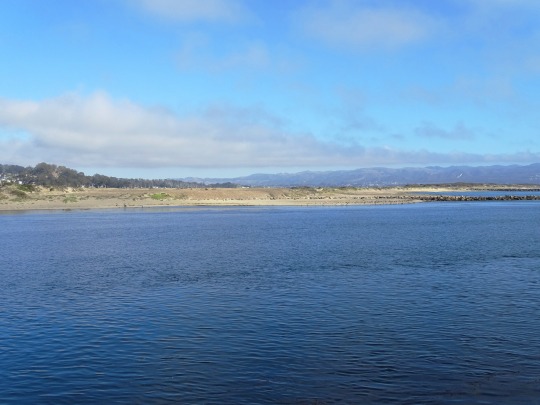


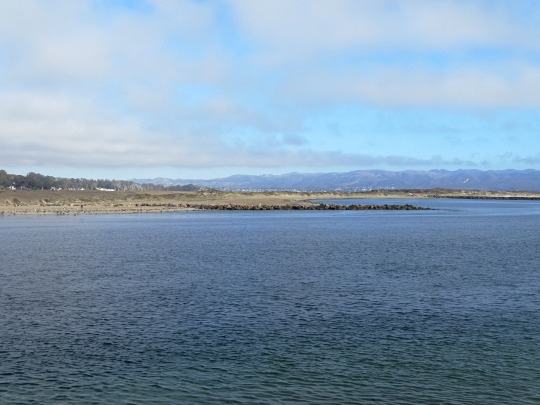


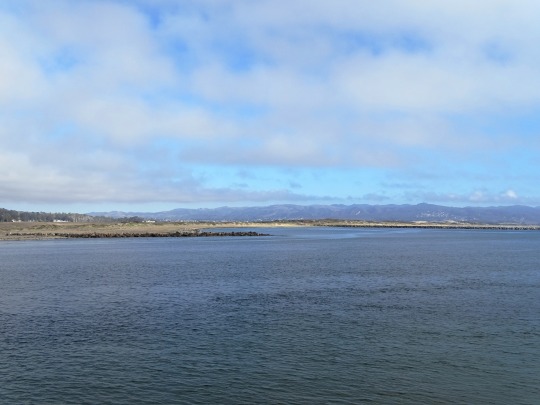



Morro Rock Ecological Preserve, CA (No. 2)
It [the Morro Rock] is composed mostly of dacite, an igneous, volcanic rock. It is a groundmass of plagioclase, with amphibole (hornblende), biotite, pyroxene (augite), quartz, and glass; it also includes phenocrysts of plagioclase. Its silicon dioxide (SiO2) content ranges from 63 to 69 percent.
The dacite volcanic plugs, lava domes, intrusive sheets, and felsitic rhyolite-dacite between Morro Rock and Islay Hill are part of the Morro Rock-Islay Hill Complex of the Oligocene epoch (from 27 to 23 million years ago). The complex lies east of the San Gregorio-San Simeon-Hosgri fault (the SG-SS-H fault). This complex is one of three probable sources of the volcanic clasts within the sandstone and conglomerate of the Miguelito and Edna members of the Pismo Formation in the Point Sur area 145–160 km (90-100 mi) to the north and west of the SG-SS-H fault. Based on paleomagnetic signatures, the Morro Rock-Islay Hill Complex was rotated 40 to 50 degrees, perhaps during late Miocene or early Pliocene time.
Source: Wikipedia
#Opuntia ficus-indica#Morro Rock Ecological Preserve#Morro Rock#Morro Bay#Pacific Ocean#sailing boat#Morro Bay Harbor#evening light#public art#sculpture#flora#nature#geology#volcanic plug#Fisherman's Family by Elizabeth MacQueen#Santa Lucia Range#Nine Sisters#San Luis Obispo County#travel#original photography#vacation#tourist attraction#landmark#cityscape#landscape#seascape#summer 2022#USA#architecture#prickly pear
1 note
·
View note
Text
EARTH SCIENCE
STRATIGRAPHY: How layering of rocks and strata are analyzed to measure geologic time.
PALEONTOLOGY: How organisms evolve and their interaction with the environment by studying fossil records often found in rocks.
MICROPALEONTOLOGY: How microfossils are characterized. Paleo is short for “paleolithic” which often refers to the geologic past.
PALEOMAGNETISM: How to reconstruct previous magnetic fields in rocks including the direction and intensity to explore pole reversals in different time periods.
GEOMORPHOLOGY: How landforms, physical features and geological structures on Earth were created and evolved.
PALEOSEISMOLOGY: The scientific study of prehistoric earthquakes and seismic activity by examining geological evidence, such as fault lines and sediment layers, to understand the history of seismic events in a region.
MAGNETOSTRATIGRAPHY: How sedimentary and volcanic sequences are dated by geophysically correlating samples of strata deposited with the Earth’s magnetic field polarity. In a nutshell, this is the field of study that studies magnetic fields in rocks and past pole reversals.
GEOCHRONOLOGY: How old rocks and geological events are dated using signatures inherent in rocks. Studying layers of rock as they relate to geologic time.
TECTONICS: How Earth’s crust evolves through time contributing to mountain building, old core continents, and earthquakes/volcanoes. This field applies the underlying principles of plate tectonics to seismology, volcanoes, earthquakes, and other geological events.
VOLCANOLOGY: How and where volcanoes and related phenomena erupt and form. As tectonics plays a key role in volcanoes, volcanology describes the types of volcanoes on Earth and their associated risk of impacting the biosphere.
SEISMOLOGY: How seismic waves travel through and around the Earth from earthquakes. We use seismic tomography from earthquakes to see inside our planet and create 3D models of the surrounding layers of Earth’s core.
NEOTECTONICS: The study of recent geological processes and their impact on the Earth’s crust, focusing on the deformation and movements occurring in the Earth’s surface in the present and near past.
TECTONOPHYSICS: How the Earth’s crust and mantle deform specific to its physical processes. Moreover, this field does target the physical process that acts on the behavior of waves.
SEISMOTECTONICS: How earthquakes, active tectonics, and individual faults are related to seismic activity.
PETROLOGY: How types of rocks (igneous, metamorphic, and sedimentary petrology) form in their specific environment. For example, petrology uses mineralogy and rock types to understand geological formations from drilling. In addition, they study the chemical properties and how atoms are arranged.
GEOLOGY: The study and science of how Earth’s landforms were created, have changed over time and how they will evolve.
■MINERALOGY: The
branch of geology that
focuses on the study of
minerals, their
composition, structure,
properties, and distribution
in nature.
GEMOLOGY: How natural and artificial gems are identified and evaluated, encompassing their identification, evaluation, and understanding of their properties and origins.
CRYSTALLOGRAPHY: The scientific study of crystals, focusing on the arrangement of atoms within crystalline solids and their geometric properties, aiding in the understanding of material structures and properties.
SOIL SCIENCES: How soil relate as a natural resource including their formation factors, classification, physical, chemical, and fertility properties. Engineering fields consider soil as regolith. But for agriculture production, soil is considered a natural resource.
■PEDOLOGY: The
scientific study of soils,
encompassing their
formation, classification,
distribution, and how they
interact with the
surrounding environment.
■EDAPHOLOGY: The
branch of soil science that
examines the influence of
soils on plants, their
growth, and the
surrounding ecosystem,
encompassing the study of
soil properties, fertility, and
their impact on agriculture
and ecology.
AGRONOMY: How the field of agriculture involves science such as crop production, biotechnology, and soil science.
HYDROGEOLOGY: How groundwater is transported and distributed in the soil, rock, and Earth’s crust. Hydrogeology specializes in anything from surface-groundwater interactions, the direction of flow for groundwater, and measuring depths to the water table.
POMOLOGY: How fruits and nuts grow. And how they are cultivated. Pomology is loosely tied to horticulture, agronomy, and agrology with a focus on producing successful crops.
SEDIMENTOLOGY: How sand, silt, and clay are deposited and the processes that act on them. By understanding erosion, movement, and deposition of sediments, sedimentologists support the search for oil reserves and contaminated sites in mining, petroleum, and research.
SURFICIAL GEOLOGY: How surface sediment (till, gravel, sand, clay, etc.) overlying bedrock was formed such as during glacial retreat or in lakes associated with these periods.
GLACIOLOGY: How ice and glacial deposits have reconstructed landforms as well as how existing (polar) glaciers behave and are distributed. Also, this field of study understands glacial movement including isostatic rebound.
GEOPHYSICS: How physical processes and properties relate to Earth and its surrounding space. Geophysicists conduct surveys to explore what’s happening beneath our feet. For example, this includes anything from searching the ground for new sources of energy or the internal structure of Earth.
BEDROCK GEOLOGY: How the intact, solid rock beneath surficial sediments formed including age (stratigraphic sequences), morphology and rock properties (folds, faults, fractures).
OROGRAPHY: How topographic relief in mountains is distributed in nature. The main focus is orography which studies topographic relief and how mountains are distributed. In addition, it’s concerned with plate tectonics which is a focal point for mountain-building events.
TOPOGRAPHY: How physical features (natural and artificial) are arranged on the landscape. We use topography in climate models, air and water flow, land formations and to better understand past tectonic activity.
HYPSOMETRY: How the height and depth of physical features are measured land from mean sea level. Hypsometry maps the terrain and processes that act on it. For example, geologists use hypsometry to understand the profile of Earth and landscape evolution.
1 note
·
View note
Text
Five steps of Wikipedia for Friday, 3rd November 2023
Welcome, Bienvenida, 你好, नमस्ते 🤗
Five steps of Wikipedia from "Blackwater Limestone" to "Arlie Russell Hochschild". 🪜👣

Start page 👣🏁: Blackwater Limestone
"The Blackwater Limestone is a geologic formation in Northern Ireland. It preserves fossils dating back to the Carboniferous period...."
Step 1️⃣ 👣: Geochronology
"Geochronology is the science of determining the age of rocks, fossils, and sediments using signatures inherent in the rocks themselves. Absolute geochronology can be accomplished through radioactive isotopes, whereas relative geochronology is provided by tools such as paleomagnetism and stable..."

Image by United States Geological Survey
Step 2️⃣ 👣: A series and B series
"In metaphysics, the A series and the B series are two different descriptions of the temporal ordering relation among events. The two series differ principally in their use of tense to describe the temporal relation between events and the resulting ontological implications regarding time. John..."
Step 3️⃣ 👣: Action (philosophy)
"In philosophy, an action is an event that an agent performs for a purpose, that is guided by the person's intention. The first question in the philosophy of action is to determine how actions differ from other forms of behavior, like involuntary reflexes. According to Ludwig Wittgenstein, it..."
Step 4️⃣ 👣: Affectional action
"An affectional action (also known as an affectual, emotional, or affective action) is one of four major types of social action, as defined by Max Weber. Unlike the other social actions, an affectional action is an action that occurs as a result of a person's state of feeling, sometimes regardless of..."
Step 5️⃣ 👣: Arlie Russell Hochschild
"Arlie Russell Hochschild (; born January 15, 1940) is an American professor emeritus of sociology at the University of California, Berkeley and writer. Hochschild has long focused on the human emotions that underlie moral beliefs, practices, and social life generally. She is the author of nine..."

Image licensed under CC BY-SA 4.0? by
File:Arlie Russell Hochschild.jpg: Paul572
derivative work: Innisfree987
0 notes
Text
there HAS to be some geology/paleomagnetism joke about the abbrevation GAD as in Generalized Anxiety Disorder and Geocentric Axial Dipole…… ill think of it
0 notes
Text
9 Online Dating Scams to Avoid
Background radiocarbon activity is measured, and the values obtained are deducted from the sample’s radiocarbon dating results. Below are a few practices I’ve implemented to maintain strong relationships and build new ones, even while I’m not out on the road. In contrast, Thomas Jefferson, who lived while the British Isles and colonies eventually converted to the Gregorian calendar, instructed that his tombstone bear his date of birth by using the Julian calendar (notated O.S. Many times, I have gone on a date only to find that I expected to see a version of that person from five or ten years ago. I’d love to see what you and your teams have come up with. Your team is watching to see how you react. נערות ליווי בקריות Our team turned around a prototype in two days. Two methods of paleomagnetic dating have been suggested: (1) the angular method and (2) the rotation method. Form tolerance: The form tolerance for two RT processes (DMLS and SLA direct-AIM) is estimated based on the experimental studies using a region elimination search-based sampling algorithm developed by Nagahanumaiah and Ravi (36). These estimated results are compared and mapped for the purpose of RT process selection, as given in Table 9. Since a form tolerance database for the other three processes (SLS, RP-IC, and spray metal tooling) is still not available, their capabilities are estimated based on experience gained from the previous RT projects.
In this study, a process capability database for a few important RT processes has been developed through experimental studies and from the reported literature. These weights are initially calculated at the feature level, and the average of them is used to map the net process capability of a specific RT process in the QFD relationship matrix. I love every morning that you are with me. FIFA have apparently ruled that Belgium will not be permitted to wear their away kit for their games at the 2022 Qatar World Cup as it has the word 'love' on the collar. Mold strength and life: In injection molding, common mold failures include (1) failure of mold core features under tensile load, resulting from part ejection force; (2) wear of ejector holes, resulting in flashes in a part and preventing retraction of the ejector pins, which may cause a larger indentation at either the parting surface or the mold cavity; (3) mold expansion and deflection caused by cyclic thermo-mechanical loading; and (4) surface wear resulting from relative movement between mold elements and part sliding over the core surfaces.
Mold cost and lead time: The cost and lead time comparisons reported by Ainsley and HaiQing (41) for different RT processes are adopted here to map their respective capabilities. The rules for cost weights calculation are designed based on the cost factors of RT (the ratio of RT cost to conventional mold cost). Maybe you’re at the point in your relationship where you’re trying to figure out if it’s the right time to say those magic words - “I love you.” Well, there are some signs you can look for to determine if the feelings are mutual or not. With these ideas in mind, multicultural therapists examine the cultural parameters of the transference (client’s feelings toward the therapist) and countertransference (therapists’ reactions to their clients). Countertransferential reactions within the inter-ethnocultural dyad are expressed as (1) denial of cultural differences; (2) the clinical anthropologist's syndrome (excessive curiosity about clients' culture at the cost of their mental health needs); (3) guilt (due to a perception of multicultural clients as being of lower social status); (4) pity (an expression of political impotence within the therapy); (5) aggression; and (6) ambivalence (toward both the therapist’s and the client’s culture). Every relationship is unique, as are the people who inhabit them.
There’s also a free blog on Medium with interesting facts about things people love to hate. What are the things we should all agree on as a team? Even if only one family member decides to hire a coach, the relationships between members often improve as the old painful feelings are addressed. However, transferential reactions in the intra-ethnocultural clinical dyad include (1) the omniscient/omnipotent clinician (client idealization of the therapist); (2) traitor (negative feelings at the clinician sharing the ethnocultural heritage); (3) auto-racist (clients project their internalized racism onto their therapist); and (4) ambivalence (where cultural familiarity coexists with cultural enmeshment). Conversely, clinicians’ examination of their internalized privilege and oppression helps to cement the therapeutic alliance. Following this reasoning, clinicians explore the potential mirroring effect of social power relations in the therapeutic dyad. For example, transferential reactions in this dyad include (1) cognitive dissonance; (2) reaction formation (clients exaggerate the therapist’s ability); (3) tokenism (clients question the therapist’s qualifications due to affirmative action); (4) xenophobia (fear of the clinician due to cultural differences); (5) fear of abandonment (anxiety about the therapist abandoning white clients for clients of color); (6) alien transformation anxiety (clients’ irrational fear that they will become a person of color); (7) ethnocultural disinhibition (unnecessary confrontation due to client perception of the therapist of color as socially inferior); and (8) racial guilt and shame.
1 note
·
View note
Text
Manico inc.

#MANICO INC. SOFTWARE#
#MANICO INC. CODE#
The Registered Agent on file for this company is Vitaliy Mani and is located at 3232 Burnt Mill Rd, Virginia Beach, VA 23452-0000. The company's filing status is listed as Inactive and its File Number is 07352651. The Registered Agent on file for this company is Legalcorp Solutions, Inc and is located at 8939 S Sepulveda Blvd Ste 102, Los Angeles, CA 90045. is a Virginia Domestic Corporation filed On March 25, 2011. The company's filing status is listed as Active and its File Number is 4023123. Chetan Navnitlal Shah and Dina Chetan Shah are presently associated as directors. Manico Inc is a California Stock Corporation - Ca - General filed On May 5, 2017. Chetan Navnitlal S.Ģ Directors are associated with the organization. Top 10 Defenses for Website Security Jim Manico VP of Security Architecture June 2012 © 2012 WhiteHat Security, Inc. It's a company limited by shares having an authorized capital of Rs 0.10 cr and a paid-up capital of Rs 0.06 cr as per MCA.Ģ Directors are associated with the organization. Advisory on spoofed emails in the name of MANI, INC It has been confirmed that there is an imposter posing to be a MANI,INC employee who sends spoofed e-mails by using MANI’s e-mail address (ms.jp). The Company's status is Active, and it has filed its Annual Returns and Financial Statements up to (FY 2020-2021). Its registered office is in Raigarh(Mh), Maharashtra, india. Manico Corporation Business Type : Trading Year Established : 1983 Main Markets : Americas,Africa,Asia,Caribbean,America,East Europe Main Products : Writing. Services Manico Inc 983 Paul Sicotte Rue Sainte-Therese QC J7E 4Z8 (450) 971-6715. To make data evaluation easier, AGICO specialists have developed several computer programs for advanced data processing supplied complimentary with the delivered instruments.Manico Resources Private Limited is a 29 years 2 months old Private Company incorporated on. Get directions, reviews and information for Services Manico Inc in Sainte-Therese, QC. They are favored for their sensitivity, very wide measuring range, compact dimensions, reliability, and acceptable price.ĪGICO Alternating Field Demagnetizers ( LDA series) are indispensable in any paleomagnetic or rock magnetic research especially when coupled with optional anhysteretic and/or low-field Pulse Magnetizers enabling to investigate, for example, Anisotropy of Magnetic Remanence, Viscous Magnetization.ĪGICO innovates its instruments systematically through computerization and automation in order to increase measurement rapidity and comfort and, if possible, sensitivity and accuracy.
#MANICO INC. SOFTWARE#
AGICO Kappabridges are the instruments of choice for a great number of paleomagnetic and rock magnetic laboratories worldwide for their outstanding sensitivity, ease of use and advanced software support.ĪGICO Spinner Magnetometers ( JR series) are probably the most sensitive and accurate commercially available instruments for measurement of remanent magnetization of rocks based on the classical (non-cryogenic) principles. The company offers multitouch tablets that are durable and its shell is made of. Its instrument making tradition goes back to the sixties when the first models of Kappabridge and Spinner Magnetometer were developed in the Geofyzika company in Brno.ĪGICO Kappabridges ( KLY and MFK series) have then gradually become worldwide standards for measurements of magnetic susceptibility of rocks, anisotropy of magnetic susceptibility (AMS), field, frequency, temperature variations of magnetic susceptibility, and, most recently, out-of-phase susceptibility. Developer of interactive tablets intended to make learning fun and interesting.
#MANICO INC. CODE#
For more than twenty years AGICO ( Advanced Geoscience Instruments COmpany) brings you excellent laboratory instruments for measurement of magnetic properties of rocks and environmental samples. Manico Inc, machine shop, listed under Machine Shops category, is located at 37105 Code Ave Willoughby OH, 44094 and can be reached by 4409465333 phone.

0 notes

